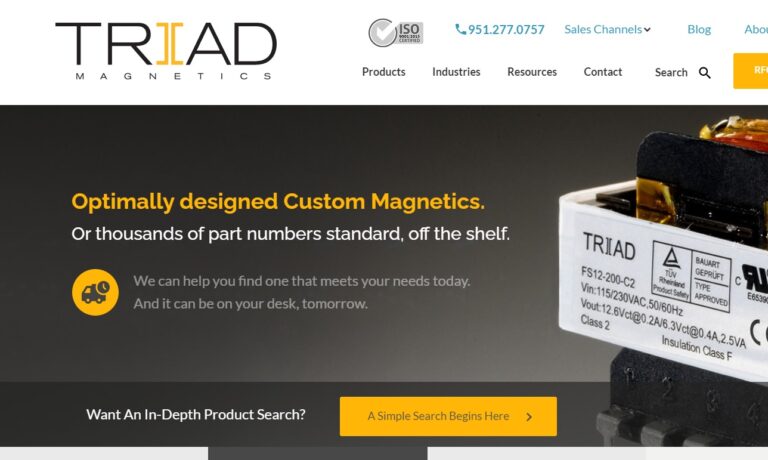Step up transformers are a very common tool used in power transforming and modification applications; they are typically the first major transformer in a power transmission system and are often used in multiple locations throughout the system. An example of this would be in power plants. Read More…
With more than 500 current transformer manufacturers in the world, Triad Magnetics realizes you have a choice. Why choose Triad? Having served the needs of many industries for more than half a century, Triad believes its experience makes the difference. And if there is one point experience has taught it, it is that it must remain flexible and adaptable to the changing needs of the market.

Lenco Electronics, Inc. specializes in a wide variety of custom electric transformers. Lenco’s success has not come about by accident, but by providing its customers with high-quality products.

Bicron Electronics specializes in high efficiency toroidal transformers up to 10KVA with safety recognitions from UL, CSA, VDE, TUV and IEC as well as high frequency transformers up to 10MHz for isolation, gate drive, pulse and switch mode functions. Bicron is ISO 9001:2000 certified.

We design and manufacture Toroidal Transformers, Inductors and Current Transformers in Connecticut, USA and Asia. Certified to UL/CSA/IEC/EN. CE marking. Applications from lighting to medical devices. Customers served Worldwide. For High Frequency Magnetics, visit our affiliate www.Induktorusa.com

ISO 9001:2000 registered Sun Transformer creates custom transformers optimized for the needs of many industries. Large power, isolation & auto transformers, printed circuit mount power transformers, units for hostile conditions, units with ferrite or nickel cores for digital telecommunications use, etc.

More Step Up Transformer Manufacturers
Electricity loses energy traveling down power lines; however, high voltage electricity loses less energy than electricity at low voltages. As a result, power plants boost, or step up, the generated electricity to an extremely high voltage before it leaves the power plant so that less electrical energy will be lost. In addition, foreign business travelers often use step down transformers for conversion to North American voltages for safe use of laptops, fax machines, cellular phones and answering machines, without worrying about short-circuiting, blowing equipment or starting a fire.
Materials used to construct the coil windings include copper, special steel alloys, chromium, nickel and aluminum, of which copper windings are the most efficient as well as being a little more costly. Sizes of step up transformers range from large devices intended for use in electrical power systems to much smaller units used in electronic equipment such as loudspeakers in radios, high fidelity equipment and television sets.
A step up transformer is comprised of two sets of coils or windings linked by a magnetic field. The core can be made of a ferrite compound or a laminated core wound with bare copper or enameled coils. The coils are primary and secondary and function as conductors. The principal function of a step up voltage transformer is to convert low voltage, high current power into high voltage, low current power. Although there is no connection between the two circuits, the coil windings are inductively linked. The primary coil serves as the input and is linked to a power generator, while the secondary coil serves as the output and is linked to the load or loads.
The conversion begins when the primary coil receives alternating current, or AC, voltage, this produces a varying magnetic field of voltage surrounding the conductor; the magnetic field activates the secondary conductor coil. Once the voltage conversion is made, the energy is transferred to the load center and the electrical process continues from there.
The ratio of turns (also known as windings) in the primary coil to the number of turns in the secondary coil determines the magnitude of the voltage; in a step down transformer there will be more turns in its secondary coil than the primary. Even though there are fewer turns, the turns in the primary coil are of a larger gauge wire than used in the secondary coil in order to handle the increased current power that has been transferred to the primary coil. The ratio of the voltage between the windings of the primary and the secondary circuit mirrors the ratio of the number of windings.















 Electric Coils
Electric Coils Electric Switches
Electric Switches Electric Transformers
Electric Transformers Electronic Connectors
Electronic Connectors Electronic Enclosures
Electronic Enclosures EMI Shielding
EMI Shielding Membrane Switches
Membrane Switches Power Cords
Power Cords Static Eliminators
Static Eliminators Castings & Forgings
Castings & Forgings Bulk Material Handling
Bulk Material Handling Electrical & Electronic Components
Electrical & Electronic Components Flow Instrumentation
Flow Instrumentation Hardware
Hardware Material Handling Equipment
Material Handling Equipment Metal Cutting Services
Metal Cutting Services Metal Forming Services
Metal Forming Services Metal Suppliers
Metal Suppliers Motion Control Products
Motion Control Products Plant & Facility Equipment
Plant & Facility Equipment Plant & Facility Supplies
Plant & Facility Supplies Plastic Molding Processes
Plastic Molding Processes Pumps & Valves
Pumps & Valves Recycling Equipment
Recycling Equipment Rubber Products & Services
Rubber Products & Services